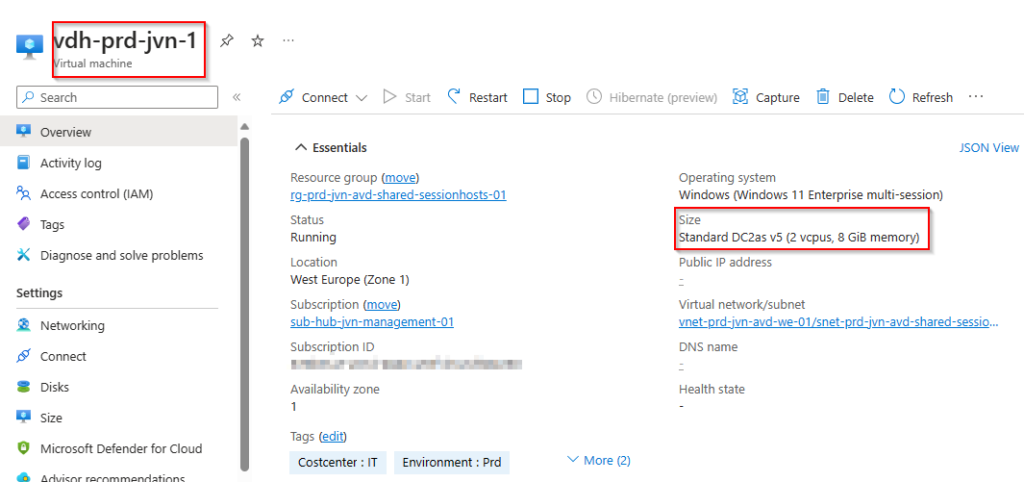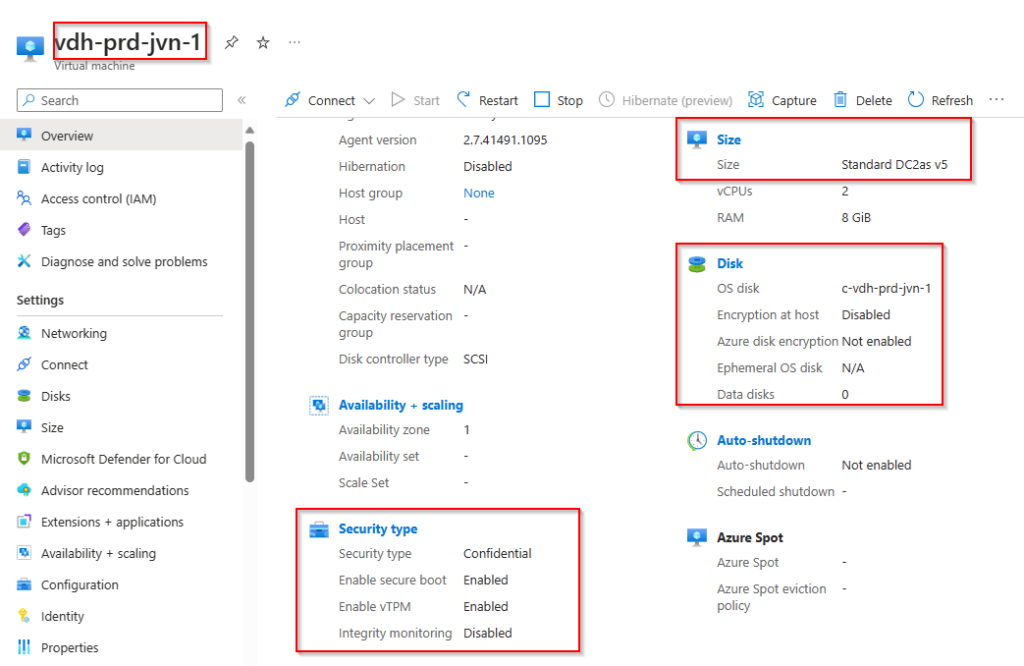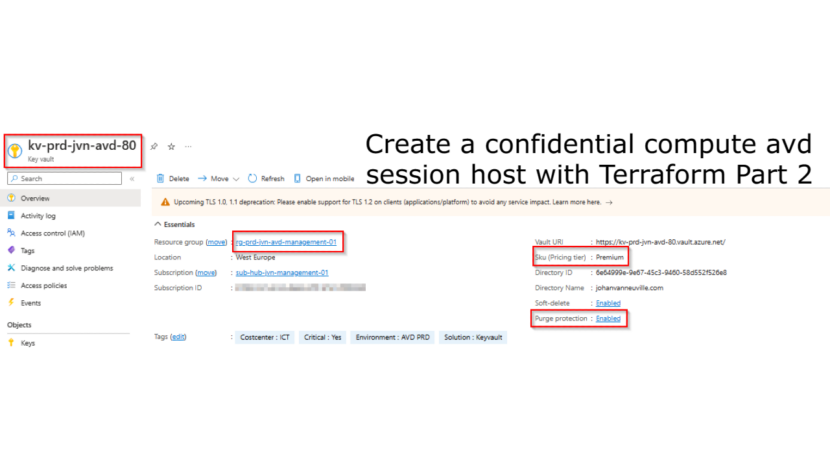Hi There,
Welcome to the 2nd part of my 2 serie blogpost about AVD on confidential virtual machines. In the first part I showed how to create the key vault, keyvault key and disk encryption set. You can check it here.
In this part I’ll focus on the deployment of a session host with Terraform.
Before we start lets see what already existing resources that we need.
- Log Analytics workspace
- storage account for boot diagnostics
- subnet for session hosts
- Key Vault
- Disk Encryption Set
- Existing host pool
terraform {
required_providers {
azurerm = {
source = "hashicorp/azurerm"
version = "=3.67.0"
}
}
}
provider "azurerm" {
features {}
}
provider "azurerm" {
features {}
alias = "hub"
subscription_id = var.subscription_id_mgmt
}
provider "azurerm" {
features {}
alias = "prod"
subscription_id = var.subscription_id_prd
}
provider "azurerm" {
features {}
alias = "identity"
subscription_id = var.subscription_id_identity
}
provider "azurerm" {
features {}
alias = "avd"
subscription_id = var.subscription_id_avd
}
data "azurerm_storage_account" "bootdiag" {
name = "sthubjvnbootdiag01"
resource_group_name = "rg-hub-jvn-storage-01"
}
data "azurerm_log_analytics_workspace" "law" {
provider = azurerm.hub
name = "law-${var.env}-${var.prefix}-01"
resource_group_name = "rg-${var.env}-${var.prefix}-management-01"
}
data "azurerm_resource_group" "rg-sessionhosts" {
provider = azurerm.avd
name = "rg-${var.spoke}-${var.prefix}-${var.solution}-shared-sessionhosts-01"
}
data "azurerm_virtual_network" "avd-vnet" {
provider = azurerm.hub
name = "vnet-${var.spoke}-${var.prefix}-${var.solution}-we-01"
resource_group_name = "rg-${var.spoke}-${var.prefix}-${var.solution}-networking-01"
}
data "azurerm_key_vault" "avd-keyvault" {
provider = azurerm.avd
name = "kv-${var.spoke}-${var.prefix}-${var.solution}-80"
resource_group_name = "rg-${var.spoke}-${var.prefix}-${var.solution}-management-01"
}
data "azurerm_key_vault_secret" "loc-admin" {
name = "loc-admin"
key_vault_id = data.azurerm_key_vault.avd-keyvault.id
}
data "azurerm_virtual_desktop_host_pool" "hp" {
provider = azurerm.hub
name = "hp-${var.spoke}-${var.prefix}-${var.solution}-we-01"
resource_group_name = "rg-${var.spoke}-${var.prefix}-${var.solution}-backplane-01"
}
data "azurerm_disk_encryption_set" "des" {
provider = azurerm.avd
name = "des-prd-jvn-avd-50"
resource_group_name = "rg-prd-jvn-avd-management-01"
}Now let’s take a look at some of the settings that we need to define that are very specific for confidential compute.
- vTPM enabled > is required
- secure boot > can be disabled but not recommended
- security encryption type for the os disk > DiskWithVMGuestState
- disk encryption set for the os disk that has been created already
- the vm sku for confidential compute > Standard_DC2as_v5
Now that we have all these prerequisites let’s have a look at the code for the session hosts itself. The code for the confidential compute is highlighted.
resource "azurerm_windows_virtual_machine" "vm" {
provider = azurerm.avd
name = "${var.vm_name}${count.index + 1}"
location = data.azurerm_resource_group.rg-sessionhosts.location
resource_group_name = data.azurerm_resource_group.rg-sessionhosts.name
size = var.vm_size
network_interface_ids = ["${element(azurerm_network_interface.nic.*.id, count.index)}"]
count = var.vm_count
license_type = "None"
vtpm_enabled = "true"
secure_boot_enabled = "true"
identity {
type = "SystemAssigned"
}
admin_username = var.admin_username
admin_password = var.admin_password
source_image_reference {
publisher = var.image_publisher
offer = var.image_offer
sku = var.image_sku
version = var.image_version
}
os_disk {
name = "c-${var.vm_name}${count.index + 1}"
caching = "ReadWrite"
storage_account_type = "Premium_LRS"
security_encryption_type = "DiskWithVMGuestState"
secure_vm_disk_encryption_set_id = data.azurerm_disk_encryption_set.des.id
}
provision_vm_agent = true
boot_diagnostics {
storage_account_uri = data.azurerm_storage_account.bootdiag.primary_blob_endpoint
}
zone = (count.index % 3) + 1
tags = {
"Location" = "We"
"Costcenter" = "IT"
"Purpose" = "AVD Session Host"
"Environment" = "Prd"
}
}
resource "azurerm_network_interface" "nic" {
provider = azurerm.avd
name = "nic-01-${var.vm_name}${count.index}"
location = data.azurerm_resource_group.rg-sessionhosts.location
resource_group_name = data.azurerm_resource_group.rg-sessionhosts.name
count = var.vm_count
ip_configuration {
name = "ipc-${var.vm_name}${count.index}"
subnet_id = var.subnet_id
private_ip_address_allocation = "Dynamic"
}
tags = {
"Location" = "We"
"Costcenter" = "IT"
"Purpose" = "AVD Session Host Nic"
"Environment" = "Prd"
}
}The final pieces of code are for the ADDS domain join and for registering the session host in the host pool.
resource "azurerm_virtual_machine_extension" "domain_join" {
count = var.vm_count
name = "${var.vm_name}-${count.index + 1}-domainJoin"
virtual_machine_id = azurerm_windows_virtual_machine.vm.*.id[count.index]
publisher = "Microsoft.Compute"
type = "JsonADDomainExtension"
type_handler_version = "1.3"
auto_upgrade_minor_version = true
settings = <<SETTINGS
{
"Name": "${var.domain}",
"OUPath": "${var.oupath}",
"User": "${var.domainuser}@${var.domain}",
"Restart": "true",
"Options": "3"
}
SETTINGS
protected_settings = <<PROTECTED_SETTINGS
{
"Password": "${var.domainpassword}"
}
PROTECTED_SETTINGS
lifecycle {
ignore_changes = [settings, protected_settings]
}
}
resource "azurerm_virtual_machine_extension" "registersessionhost" {
name = "registersessionhost"
virtual_machine_id = azurerm_windows_virtual_machine.vm[count.index].id
depends_on = [
azurerm_windows_virtual_machine.vm
]
publisher = "Microsoft.Powershell"
count = var.vm_count
type = "DSC"
type_handler_version = "2.73"
auto_upgrade_minor_version = true
settings = <<SETTINGS
{
"ModulesUrl": "${var.artifactslocation}",
"ConfigurationFunction" : "Configuration.ps1\\AddSessionHost",
"Properties": {
"hostPoolName": "${data.azurerm_virtual_desktop_host_pool.hp.name}"
}
}
SETTINGS
protected_settings = <<PROTECTED_SETTINGS
{
"properties" : {
"registrationInfoToken" : "${azurerm_virtual_desktop_host_pool_registration_info.avd_token.token}"
}
}
PROTECTED_SETTINGS
lifecycle {
ignore_changes = [settings, protected_settings]
}
}Let’s see what we can see in the portal after deploying this session host.

You will see the security type is confidential. The option Integrity Monitoring isn’t active because currently Terraform doesn’t support this option. I opened a feature request for this on Github.

When we check out the OS disk we can see the encryption type. Here we can see it’s using a customer managed key.



There you go, an Azure Virtual Desktop session host running on confidential compute hardware. Using this feature will improve your security a lot.
As usual you can find the code on my Github here.
In case you have any questions about this blog post feel free to leave a comment or to contact me on my socials.

1 thought on “Create a confidential compute avd session host with Terraform part 2”